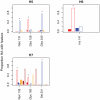Emergence and genetic variation of neuraminidase stalk deletions in avian influenza viruses
- PMID: 21373190
- PMCID: PMC3044137
- DOI: 10.1371/journal.pone.0014722
Emergence and genetic variation of neuraminidase stalk deletions in avian influenza viruses
Abstract
When avian influenza viruses (AIVs) are transmitted from their reservoir hosts (wild waterfowl and shorebirds) to domestic bird species, they undergo genetic changes that have been linked to higher virulence and broader host range. Common genetic AIV modifications in viral proteins of poultry isolates are deletions in the stalk region of the neuraminidase (NA) and additions of glycosylation sites on the hemagglutinin (HA). Even though these NA deletion mutations occur in several AIV subtypes, they have not been analyzed comprehensively. In this study, 4,920 NA nucleotide sequences, 5,596 HA nucleotide and 4,702 HA amino acid sequences were analyzed to elucidate the widespread emergence of NA stalk deletions in gallinaceous hosts, the genetic polymorphism of the deletion patterns and association between the stalk deletions in NA and amino acid variants in HA. Forty-seven different NA stalk deletion patterns were identified in six NA subtypes, N1-N3 and N5-N7. An analysis that controlled for phylogenetic dependence due to shared ancestry showed that NA stalk deletions are statistically correlated with gallinaceous hosts and certain amino acid features on the HA protein. Those HA features included five glycosylation sites, one insertion and one deletion. The correlations between NA stalk deletions and HA features are HA-NA-subtype-specific. Our results demonstrate that stalk deletions in the NA proteins of AIV are relatively common. Understanding the NA stalk deletion and related HA features may be important for vaccine and drug development and could be useful in establishing effective early detection and warning systems for the poultry industry.
Conflict of interest statement
Figures





Similar articles
-
H9N2 Influenza Virus Infections in Human Cells Require a Balance between Neuraminidase Sialidase Activity and Hemagglutinin Receptor Affinity.J Virol. 2020 Aug 31;94(18):e01210-20. doi: 10.1128/JVI.01210-20. Print 2020 Aug 31. J Virol. 2020. PMID: 32641475 Free PMC article.
-
Deglycosylation and truncation in the neuraminidase stalk are functionally equivalent in enhancing the pathogenicity of a high pathogenicity avian influenza virus in chickens.J Virol. 2025 Mar 18;99(3):e0147824. doi: 10.1128/jvi.01478-24. Epub 2025 Feb 14. J Virol. 2025. PMID: 39950775 Free PMC article.
-
Changes in the haemagglutinin and the neuraminidase genes prior to the emergence of highly pathogenic H7N1 avian influenza viruses in Italy.Arch Virol. 2001;146(5):963-73. doi: 10.1007/s007050170128. Arch Virol. 2001. PMID: 11448033
-
Influenza pathobiology and pathogenesis in avian species.Curr Top Microbiol Immunol. 2014;385:221-42. doi: 10.1007/82_2014_385. Curr Top Microbiol Immunol. 2014. PMID: 25015786 Review.
-
Variability among the neuraminidase, non-structural 1 and PB1-F2 proteins in the influenza A virus genome.Virus Genes. 2012 Jun;44(3):363-73. doi: 10.1007/s11262-012-0714-0. Epub 2012 Jan 20. Virus Genes. 2012. PMID: 22261818 Review.
Cited by
-
Evolutionary Timeline and Genomic Plasticity Underlying the Lifestyle Diversity in Rhizobiales.mSystems. 2020 Jul 14;5(4):e00438-20. doi: 10.1128/mSystems.00438-20. mSystems. 2020. PMID: 32665328 Free PMC article.
-
Inventory of molecular markers affecting biological characteristics of avian influenza A viruses.Virus Genes. 2019 Dec;55(6):739-768. doi: 10.1007/s11262-019-01700-z. Epub 2019 Aug 19. Virus Genes. 2019. PMID: 31428925 Free PMC article. Review.
-
Influenza Hemagglutinin and Neuraminidase: Yin⁻Yang Proteins Coevolving to Thwart Immunity.Viruses. 2019 Apr 16;11(4):346. doi: 10.3390/v11040346. Viruses. 2019. PMID: 31014029 Free PMC article. Review.
-
Vaccination and Antiviral Treatment against Avian Influenza H5Nx Viruses: A Harbinger of Virus Control or Evolution.Vaccines (Basel). 2023 Oct 24;11(11):1628. doi: 10.3390/vaccines11111628. Vaccines (Basel). 2023. PMID: 38005960 Free PMC article. Review.
-
Selection of an Optimal Recombinant Egyptian H9N2 Avian Influenza Vaccine Strain for Poultry with High Antigenicity and Safety.Vaccines (Basel). 2022 Jan 21;10(2):162. doi: 10.3390/vaccines10020162. Vaccines (Basel). 2022. PMID: 35214621 Free PMC article.
References
-
- Olsen B, Munster VJ, Wallensten A, Waldenstrom J, Osterhaus AD, et al. Global patterns of influenza a virus in wild birds. Science. 2006;312:384–388. - PubMed
-
- Munster VJ, Fouchier RA. Avian influenza virus: of virus and bird ecology. Vaccine. 2009;27:6340–6344. - PubMed
-
- Capua I, Marangon S. The avian influenza epidemic in Italy, 1999-2000: a review. Avian Pathol. 2000;29:289–294. - PubMed
Publication types
MeSH terms
Substances
LinkOut - more resources
Full Text Sources
Other Literature Sources

